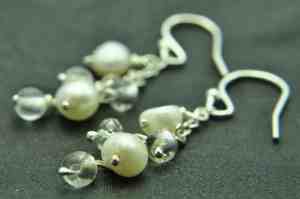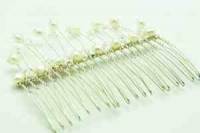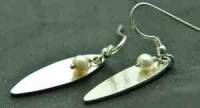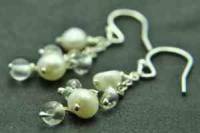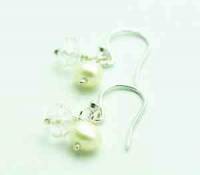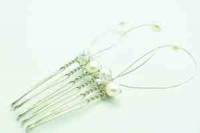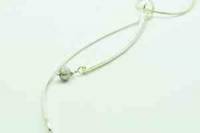I’ve been wanting to start doing monthly blog posts on my favourite stones. So I would like to start with this month. As it is June, the birth stone for this month is the Pearl. June is also the time for many weddings taking place so I’d thought I’d mention that I use pearls in my wedding and bridal jewellery to add elegance, and to create timeless classic pieces.
- Large Haircomb Twist White Bangle
- Leaf Pearl Drops
- Pearl Crystal Chain Drop Earrings
If you would like to know some technical detail about the pearl here is some information below.
“A pearl is a hard object produced within the soft tissue (specifically the mantle) of a living shelled mollusc. Just like the shell of a clam, a pearl is made up of calcium carbonate in minute crystalline form, which has been deposited in concentric layers. The ideal pearl is perfectly round and smooth, but many other shapes of pearls (baroque pearls) occur. The finest quality natural pearls have been highly valued as gemstones and objects of beauty for many centuries, and because of this, the word pearl has become a metaphor for something very rare, fine, admirable, and valuable.
The most valuable pearls occur spontaneously in the wild, but they are extremely rare. These wild pearls are referred to as natural pearls. Cultured or farmed pearls from pearl oysters and freshwater mussels make up the majority of those that are currently sold. Imitation pearls are also widely sold in inexpensive jewelry, but the quality of their iridescence is usually very poor, and often, artificial pearls are easily distinguished from genuine pearls. Pearls have been harvested and cultivated primarily for use in jewelry, but in the past they were also stitched onto lavish clothing. Pearls have also been crushed and used in cosmetics, medicines, and in paint formulations.
Whether wild or cultured, gem quality pearls are almost always nacreous and iridescent, as is the interior of the shell that produces them. However, almost all species of shelled molluscs are capable of producing pearls (formally referred to as “calcareous concretions” by some sources) of lesser shine or less spherical shape. Although these may also be legitimately referred to as “pearls” by gemological labs and also under U.S. Federal Trade Commission rules, and are formed in the same way, most of them have no value, except as curiosities.” taken from Wikipedia
I mainly use FRESHWATER pearls in my jewellery. I love the fact that they are irregular and have lots of character.
- Pearl Crystal Hook
- Small Comb Loop Pearl Crystal
- Textured Drop Necklace
- Textured Wire Pearl Pendant
Freshwater and saltwater pearls may sometimes look quite similar, but they come from different sources.
Freshwater pearls form in various species of freshwater mussels, family Unionidae, which live in lakes, rivers, ponds and other bodies of fresh water. These freshwater pearl mussels occur not only in hotter climates, but also in colder more temperate areas such as Scotland (where they are totally protected under law). However, most freshwater cultured pearls sold today come from China.
Saltwater pearls grow within pearl oysters, family Pteriidae, which live in oceans. Saltwater pearl oysters are usually cultivated in protected lagoons or volcanic atolls.
For more information about the pearl check out wikipedia or search for pearl online.
If you like any of the pieces pictured here please get in touch. They will be listed on my facebook page and available to purchase from my online shop soon. There is only one of each piece so get in touch if you would like to purchase a piece now.

